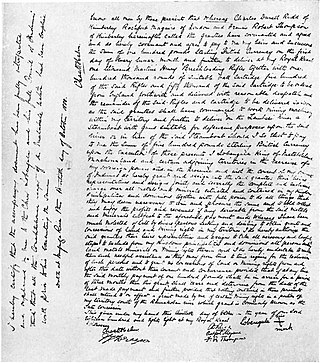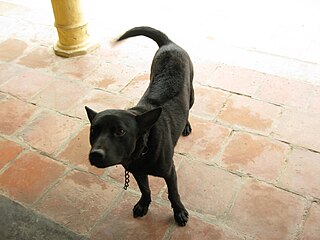Related Research Articles

A hound is a type of hunting dog used by hunters to track or chase prey.

The Rhodesian Ridgeback is a large dog breed originally bred in Southern Africa. The original breed standard was drafted by F.R. Barnes, in Bulawayo, Southern Rhodesia, in 1922, and approved by the South African Kennel Union in 1927. Its forebears can be traced to the ridged hunting and guardian dogs of the Khoikhoi. These were interbred with European dogs by the early colonists of the Cape Colony for assisting in the hunting of lions.

Southern Rhodesia was a landlocked, self-governing British Crown colony in Southern Africa, established in 1923 and consisting of British South Africa Company (BSAC) territories lying south of the Zambezi River. The region was informally known as South Zambesia until annexation by Britain, at the behest of Cecil Rhodes's British South Africa Company. The bounding territories were Bechuanaland (Botswana), Northern Rhodesia (Zambia), Portuguese Mozambique (Mozambique) and the Transvaal Republic.

Lobengula Khumalo was the second and last official king of the Northern Ndebele people. Both names in the Ndebele language mean "the men of the long shields", a reference to the Ndebele warriors' use of the Nguni shield.

Matabeleland is a region located in southwestern Zimbabwe that is divided into three provinces: Matabeleland North, Bulawayo, and Matabeleland South. These provinces are in the west and south-west of Zimbabwe, between the Limpopo and Zambezi rivers and are further separated from Midlands by the Shangani River in central Zimbabwe. The region is named after its inhabitants, the Ndebele people who were called "Amatabele"(people with long shields – Mzilikazi 's group of people who were escaping the Mfecani wars). Other ethnic groups who inhabit parts of Matabeleland include the Tonga, Bakalanga, Venda, Nambya, Khoisan, Xhosa, Sotho, Tswana, and Tsonga.

The Pioneer Column was a force raised by Cecil Rhodes and his British South Africa Company in 1890 and used in his efforts to annex the territory of Mashonaland, later part of Zimbabwe.

Frederick Courteney Selous, DSO was a British explorer, officer, professional hunter, and conservationist, famous for his exploits in Southeast Africa. His real-life adventures inspired Sir Henry Rider Haggard to create the fictional character Allan Quatermain. Selous was a friend of Theodore Roosevelt, Cecil Rhodes and Frederick Russell Burnham. He was pre-eminent within a group of big game hunters that included Abel Chapman and Arthur Henry Neumann. He was the older brother of the ornithologist and writer Edmund Selous.

Dirk Van der Hoff was minister of the Nederduitsch Hervormde Kerk, one of the Dutch Reformed Churches in South Africa.

The First Matabele War was fought between 1893 and 1894 in modern-day Zimbabwe. It pitted the British South Africa Company against the Ndebele (Matabele) Kingdom. Lobengula, king of the Ndebele, had tried to avoid outright war with the company's pioneers because he and his advisors were mindful of the destructive power of European-produced weapons on traditional Matabele impis attacking in massed ranks. Lobengula reportedly could muster 80,000 spearmen and 20,000 riflemen, armed with Martini-Henry rifles, which were modern arms at that time. However, poor training may have resulted in the weapons not being used effectively.

The Second Matabele War, also known as the First Chimurenga, was fought in 1896 and 1897 in the region later known as Southern Rhodesia, now modern-day Zimbabwe. It pitted the British South Africa Company against the Matabele people, which led to conflict with the Shona people in the rest of Southern Rhodesia.

The Rudd Concession, a written concession for exclusive mining rights in Matabeleland, Mashonaland and other adjoining territories in what is today Zimbabwe, was granted by King Lobengula of Matabeleland to Charles Rudd, James Rochfort Maguire and Francis Thompson, three agents acting on behalf of the South African-based politician and businessman Cecil Rhodes, on 30 October 1888. Despite Lobengula's retrospective attempts to disavow it, it proved the foundation for the royal charter granted by the United Kingdom to Rhodes's British South Africa Company in October 1889, and thereafter for the Pioneer Column's occupation of Mashonaland in 1890, which marked the beginning of white settlement, administration and development in the country that eventually became Rhodesia, named after Rhodes, in 1895.

The military history of Zimbabwe chronicles a vast time period and complex events from the dawn of history until the present time. It covers invasions of native peoples of Africa, encroachment by Europeans, and civil conflict.

The Phu Quoc Ridgeback is a rare breed of dog from the island of Phú Quốc in Kiên Giang Province in southern Vietnam. It is one of three ridgeback breeds, the others being the Rhodesian Ridgeback and the Thai Ridgeback. It is not recognized by the Fédération Cynologique Internationale or any other major club. The Phu Quoc Ridgeback is one of the four native Vietnamese dog breeds, along with the Bắc Hà dog, Lài dog, Hmong Bobtail Dog.
Major Patrick William Forbes was a British South Africa Police officer who commanded a British South Africa Company force which invaded Matabeland during the First Matabele War.

Shangani Patrol is a war film based upon the non-fiction book A Time to Die by Robert Cary (1968), and the historical accounts of the Shangani Patrol, with Brian O'Shaughnessy as Major Allan Wilson and Will Hutchins as the lead Scout Frederick Russell Burnham. Also includes the song "Shangani Patrol" by Nick Taylor.

The Shangani Patrol was a 34-soldier unit of the British South Africa Company that in 1893 was ambushed and annihilated by more than 3,000 Matabele warriors in pre-Southern Rhodesia, during the First Matabele War. Headed by Major Allan Wilson, the patrol was attacked just north of the Shangani River in Matabeleland, Rhodesia. Its dramatic last stand, sometimes called "Wilson's Last Stand", achieved a prominent place in the British public imagination and, subsequently, in Rhodesian history, similarly to events such as the Battle of the Little Bighorn and the Battle of the Alamo in the United States.
Van Rooyen or Van Rooijen is an Afrikaans and Dutch toponymic surname. "Rooij" or "Roij" was a local term for many towns ending with "rode" or "roij", like Nistelrode, Sint-Oedenrode, Stramproy and Wanroij. This suffix itself means "a clearing made by men". Notable people with the surname include:

The British South Africa Company's administration of what became Rhodesia was chartered in 1889 by Queen Victoria of the United Kingdom, and began with the Pioneer Column's march north-east to Mashonaland in 1890. Empowered by its charter to acquire, govern and develop the area north of the Transvaal in southern Africa, the Company, headed by Cecil Rhodes, raised its own armed forces and carved out a huge bloc of territory through treaties, concessions and occasional military action, most prominently overcoming the Matabele army in the First and Second Matabele Wars of the 1890s. By the turn of the century, Rhodes's Company held a vast, land-locked country, bisected by the Zambezi river. It officially named this land Rhodesia in 1895, and ran it until the early 1920s.
Charles Daniel Helm was a Protestant missionary and trusted confident of King Lobengula of Matabeleland who played a controversial role as an interpreter during the drafting and signing of the Rudd Concession with agents of Cecil Rhodes's British South Africa Company in 1888.
References
- ↑ Dutch Reformed Church Alexandria, Cape Colony, entry 325/1890, p. 657.
- 1 2 3 "Cornelius (Nellis) Johannes van Rooyen". geni_family_tree. 5 November 1860. Retrieved 2022-12-22.
- 1 2 3 "The men who created the Rhodesian Ridgeback dog we know today? (continued from Dec/Jan Bundu Times) – Rhodesian Association of WA (RAWA)" . Retrieved 2022-12-24.
- ↑ "HISTORY OF THE BREED". GLENAHOLM RHODESIAN RIDGEBACKS. Retrieved 2022-12-24.
- ↑ Nederduitsch Hervormde Kerk Potchefstroom baptism register, p. 136 (1867).
- ↑ "The Project Gutenberg eBook of Sunshine and Storm in Rhodesia, by Frederick Courteney Selous". www.gutenberg.org. Retrieved 2022-12-22.
- ↑ "HISTORY OF THE BREED". GLENAHOLM RHODESIAN RIDGEBACKS. Retrieved 2024-01-08.
- ↑ "A HUNTER OF BIG GAME". Barrier Miner. 1910-04-27. p. 6. Retrieved 2022-12-25.
- ↑ Rhodesia Civil Deaths Entry 15/1915, Cornelis Johannes van Rooyen, for Bulawayo, Rhodesia available via www.familysearch.org.
- ↑ Rhodesia Civil Deaths Entry 16/1916, Maria Margaretha van Rooyen (born Vermaak) for Bulawayo, Rhodesia available via www.familysearch.org.